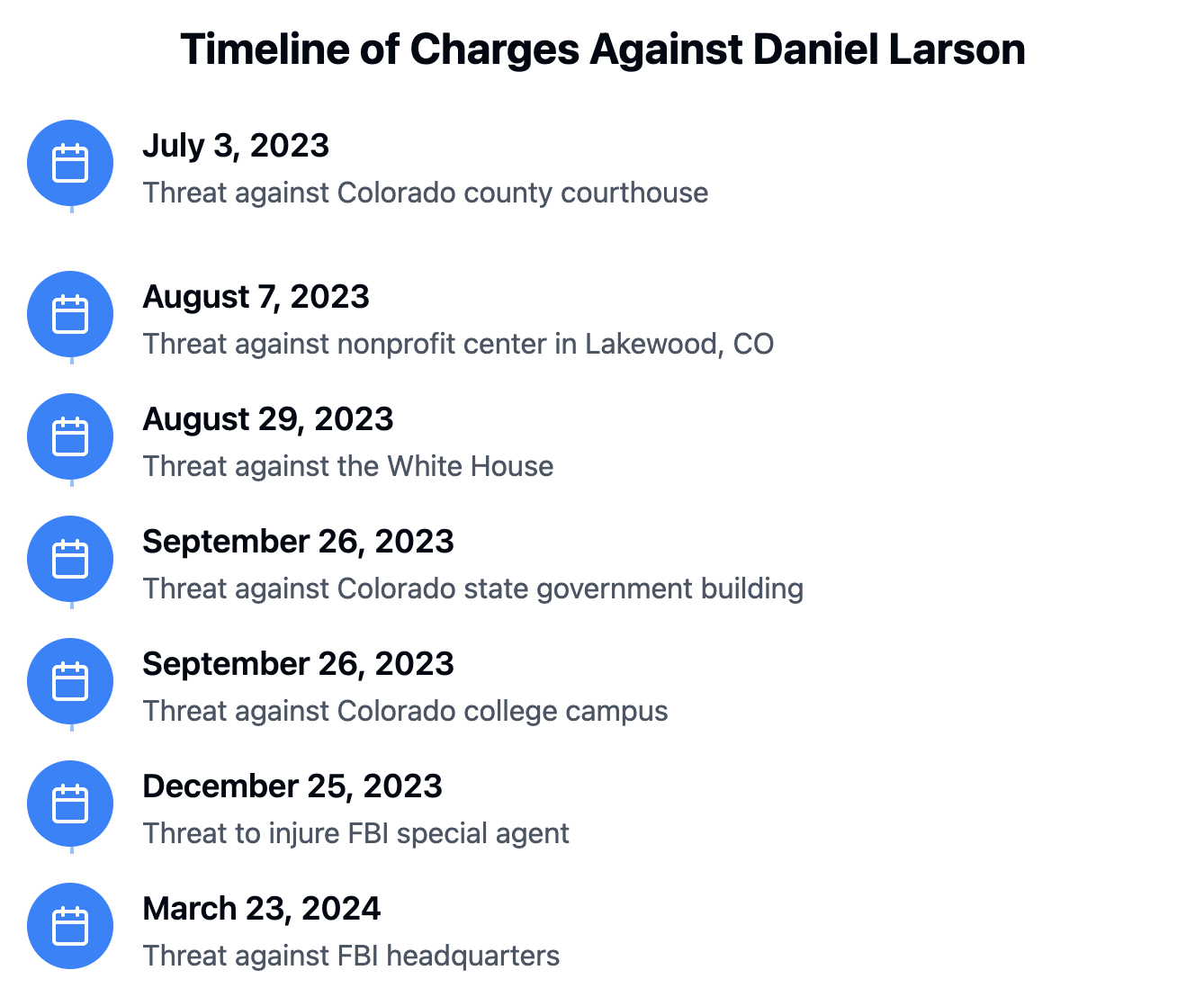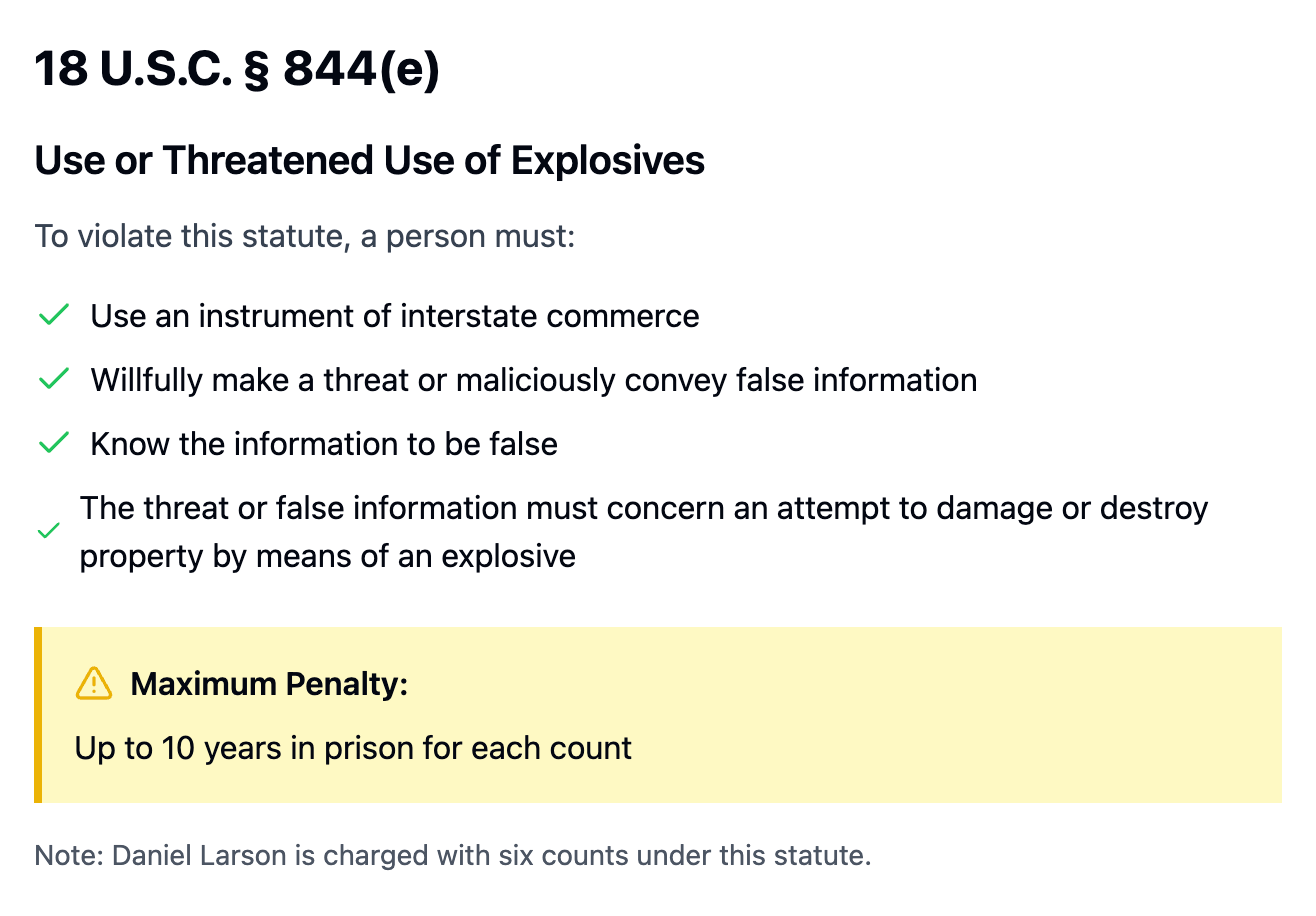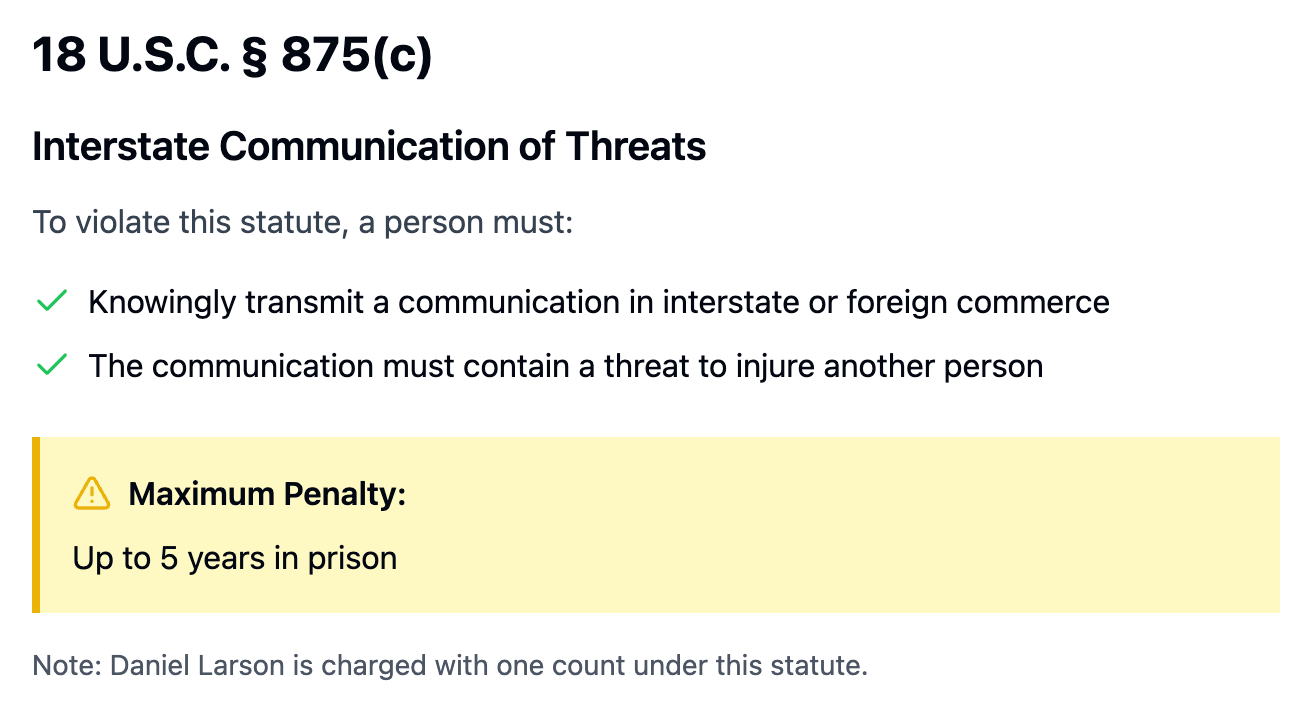Blurring the line between trolling and terrorism, TikToker Daniel Larson is facing federal charges for threatening to blow up everything from a local nonprofit to the White House—leaving the country wondering: was he joking, or dead serious?
Overview
This case is about videos Larson posted in which he threatened to destroy government and other property, namely:
- a county courthouse in Colorado
- a nonprofit center in Lakewood, Colorado
- The White House
- a state government building in Colorado
- a college campus in Colorado
- The Federal Bureau of Investigation headquarters
Mr. Larson also communicated a threat to injure a Federal Bureau of Investigation special agent.
If you've ever seen a Daniel Larson video, you know that he gains attention online by doing absolutely wild things in public. For example, in one of his viral videos, he accused an Olive Garden worker of printing out naked photos of him in the back office. She obviously freaked out and he continued to escalate the scene to the point where he attempted to place numerous employees under citizens arrest and pulled a fire alarm. I'm pretty sure he ended up getting arrested.
So while we consider the charges and indictment, it's important to keep in mind the following fact.
Daniel Larson is a troll.
Let's get into the initial charges.
The United States District Court for the District of Colorado has levied serious charges against Larson, painting a picture of a months-long campaign of terror that targeted various institutions across the nation.
Please note that charges are not convictions, and this information may be subject to change.

Key Takeaways
- Daniel Larson faces seven federal counts, including six for use or threatened use of explosives and one for interstate communication of threats.
- The alleged threats targeted various locations, including government buildings, educational institutions, and federal agencies.
- Larson's case highlights the intersection of social media, criminal law, and mental health issues.
- The outcome of this case could have significant implications for how online threats are handled in the future.
The Indictment
On April 25, 2024, the United States District Court for the District of Colorado handed down an indictment against Daniel Larson in Criminal Case No. 24-cr-130-RMR. A Grand Jury formally charged Larson with seven federal offenses, largely centered on threats involving explosives and interstate communications.
Larson faces the following charges:
- Six counts of use or threatened use of explosives (18 U.S.C. § 844(e))
- One count of interstate communication of threats (18 U.S.C. § 875(c))
These charges stem from an investigation into multiple alleged threats made by Larson via TikTok and YouTube between July 2023 and March 2024, where he targeted government institutions and individuals across various locations.
Detailed Breakdown of the Indictment
Count 1: July 3, 2023 Threat
The first count alleges that on or about July 3, 2023, Larson used an instrument of interstate commerce to willfully make a threat concerning an attempt to damage or destroy a county courthouse in Colorado by means of an explosive.
Count 2: August 7, 2023 Threat
The second count relates to a similar threat made on August 7, 2023, this time targeting a nonprofit center in Lakewood, Colorado.
Count 3: August 29, 2023 Threat
Count three involves a threat made on August 29, 2023, directed at the White House.
Counts 4 and 5: September 26, 2023 Threats
On September 26, 2023, Larson allegedly made two separate threats:
- Against a state government building in Colorado
- Targeting a particular college campus in Colorado
Count 6: December 25, 2023 Threat
The sixth count differs from the others in that it falls under a separate statute. On December 25, 2023, Larson is accused of knowingly transmitting in interstate commerce a communication containing a threat to injure a specific FBI special agent.
Count 7: March 23, 2024 Threat
The final count alleges that on March 23, 2024, Larson made a threat concerning an attempt to damage or destroy the FBI headquarters.
Legal Analysis of the Charges
18 U.S.C. § 844(e): Use or Threatened Use of Explosives
Six of the seven counts against Larson fall under this statute. To secure a conviction, prosecutors must prove beyond a reasonable doubt that Larson:
- Used an instrument of interstate commerce
- Willfully made a threat or maliciously conveyed false information
- Knew the information to be false
- The threat or false information concerned an attempt to damage or destroy a building or other property by means of an explosive

Key Elements:
- Interstate Commerce: The prosecutors are alleging that the use of social media platforms like TikTok and YouTube satisfies this element, as these services operate across state lines.
- Willfulness: Prosecutors must demonstrate that Larson acted with intent, not merely recklessly or negligently.
18 U.S.C. § 875(c): Interstate Communication of Threats
The sixth count falls under this separate statute. To prove this charge, prosecutors must establish that Larson:
- Knowingly transmitted a communication in interstate or foreign commerce
- The communication contained a threat to injure another person

Key Elements:
- Knowingly: This implies that Larson was aware of the threatening nature of his communication.
- Interstate Commerce: Again, the use of social media likely satisfies this element.
- Threat to Injure: The specific nature of the threat against an FBI agent distinguishes this count from the others.
Potential Defenses and Legal Challenges
First Amendment Considerations
Larson’s defense team could argue that his statements are protected under the First Amendment as free speech. However, the challenge lies in the fact that true threats—statements where a reasonable person would interpret them as a serious expression of intent to harm—are not protected by the Constitution. The specific, targeted nature of Larson’s alleged threats, especially toward government buildings and officials, makes this a difficult defense to sustain.
Intent and Knowledge
A key aspect of Larson’s defense may center on whether he truly intended his statements as threats. His legal team could argue that the comments were made in jest, as part of his known online persona as a provocateur, and that he did not seriously intend to follow through. Establishing his mental state at the time of the threats could be critical here, especially if they can demonstrate that the statements were exaggerated hyperbole or meant as trolling rather than genuine intent to cause harm.
Interstate Commerce Clause
While the prosecution argues that the use of platforms like TikTok and YouTube meets the interstate commerce requirement, the defense may contest whether all of Larson’s communications actually crossed state lines. If any of the alleged threats were communicated solely within Colorado, they could challenge the application of federal jurisdiction on those counts.
Specificity of Threats
The defense might argue that some of the alleged threats were too vague or lacked specific details to constitute true threats under the law. In such cases, the defense could claim that Larson’s statements were not sufficiently concrete or directed at a specific target, which could weaken the prosecution’s case.
Procedural Aspects of the Case
Pre-Trial Detention
Daniel Larson has been transferred from Boulder to a federal detention center, where he remains in custody awaiting trial. This suggests that the court considers him either a flight risk or a danger to the community, or both.
Prosecution Team
The case is being prosecuted by Assistant U.S. Attorney Alison Connaughty from the U.S. Attorney's Office in Denver. The involvement of a federal prosecutor underscores the seriousness with which the government is treating these charges.
Potential Penalties
If convicted, Larson faces serious consequences:
- Each count under 18 U.S.C. § 844(e) (threatened use of explosives) carries a maximum sentence of up to 10 years in federal prison.
- The charge under 18 U.S.C. § 875(c) (interstate communication of threats) is punishable by up to 5 years in prison.
With seven counts in total, Larson could potentially face decades in federal prison.
Implications of the Case
Social Media and Criminal Liability
This case underscores a new reality: what starts as a post can quickly become a prison sentence. As social platforms become stages for everything from jokes to dangerous rhetoric, the legal consequences are catching up. Larson’s indictment shows that even if threats are arguably outlandish or unserious, they can still bring serious federal charges.
Prosecutorial Focus on Threats
Larson’s case is part of a larger trend where prosecutors are aggressively targeting threats made online, especially those involving government institutions.
This sends a clear message: threats—even if for attention, laughs, or trolling—won't be taken lightly.
Balancing Security and Free Speech
The case raises important questions about where to draw the line between protected speech and criminal threats, particularly in the context of social media where hyperbole and exaggeration are common.
With online spaces becoming increasingly casual and exaggerated, the Larson case could set a major precedent on how far “just joking” can go.


